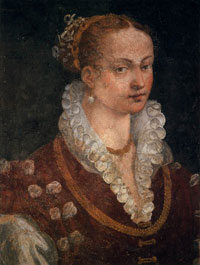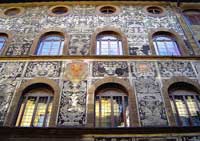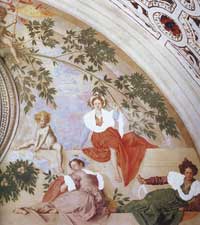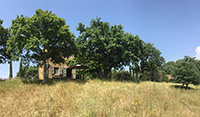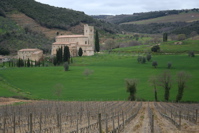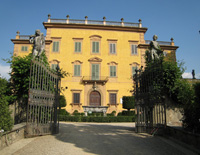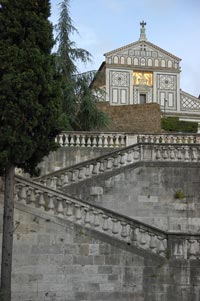 |
|
|
I T |
Alessandro Allori, Portrait of Bianca Cappello, Second Wife of Francesco I de' Medici, c. 1580, fresco, Galleria degli Uffizi, Firenze |
Bianca Cappello |
Bianca Cappello (1548 – 17 October 1587) was an Italian noblewoman who was the mistress, and afterward the second wife, of Francesco I de' Medici, Grand Duke of Tuscany. Her husband officially made her his consort. |
| Grand Duke Francesco I de' Medici was a man of profound and obsessive passions. The Uffizi galleries, which he established, were one, Bianca Cappello (1548-1587), his mistress, and afterwards, the second wife, was the other. On the death of Cosimo in 1574 Francesco succeeded to the grand duchy; he now installed Bianca in a palace (now known as Palazzo di Bianca Cappello) close to his own and outraged his wife by flaunting his mistress before her. As Giovanna had borne Francesco only one son, Filippo (20 May 1577 – 29 March 1582) who died as a juvenile, and six daughters, of whom, only two lived to adulthood, Bianca was very anxious to present him with an heir, for otherwise her position would remain very insecure. In 1576 she gave birth to Don Antonio de' Medici (d. 1621), but he was not openly acknowledged as Francesco's heir until after Joanna's death, when the boy was about three years old.[4] Marriage |
||
| In 1578 Giovanna died; a few months later Francesco secretly married Bianca, and on 10 June 1579, the marriage was publicly announced. Two days later, on the 12 June, Bianca was crowned the Grand Duchess of Tuscany at the Palazzo Vecchio in Florence. The Venetian government now put aside its resentment and was officially represented at the magnificent wedding festivities, for it saw in Bianca Cappello an instrument for cementing good relations with Tuscany. But the long expected heir failed to come, and Bianca realized that if her husband were to die before her she was lost, for his family, especially his brother Cardinal Ferdinand, hated her bitterly, as an adventuress and interloper.[5] In October 1587, at the Villa Medici in Poggio a Caiano, Francesco and Bianca died on the same day, possibly poisoned, or as some historians believe, from malarial fever. In 2006, forensic and toxicology experts at the University of Florence reported evidence of arsenic poisoning in a study published in the British Medical Journal,[6] but in 2010 evidence of the parasite Plasmodium falciparum, which causes malaria, was found in Francesco's remains.[7] Soon after the sudden and simultaneous deaths of Francesco I de' Medici, Grand Duke of Tuscany, and his wife, Bianca Cappello, in October 1587, rumours spread that the two had been murdered by Francesco's brother, Cardinal Ferdinando. Apparently, Ferdinando had a very good motive to kill his brother and the woman that Francesco had loved and then married after the death of his first wife the Grand Duchess Giovanna of Austria. Ferdinando was at risk of being excluded from the succession if Francesco's illegitimate son Don Antonio was to inherit the title of Grand Duke or, even worse, if Bianca, who was no longer able to have children, was to falsify the birth of an heir.'[8] Montaigne, the French writer, described Bianca in diplomatic terms:" According to the Italians [she] is beautiful. She has an agreeable and imposing face, and large breasts, the way they like them here…” |
||
Giardino degli Orti Oricellari | Florence |
||
'The palazzo with adjoining garden was built in the late 15th century on property belonging to Nannina de’ Medici, sister of Lorenzo the Magnificent, and her husband Bernardo Rucellai. The complex was a very important cultural centre as it hosted, after the Medici’s expulsion, the meetings of the Platonic Academy formerly held at the Villa of Careggi where Rucellai too, had also participated. The name of the garden (also known as selva) comes from that of the Rucellai family, an ancestor of which introduced ruscus to Florence, a grass used to dye wool violet and called Oricella or Lichen Roccella in Linnaeus’ classification.
|
||
Enlarge map Giardino degli Orti Oricellari |
||
| Giuseppe Stiozzi Ridolfi, the new owner in the mid 19th century, transformed the garden, entrusting the project to Luigi de Cambray Digny who evocatively interpreted the theoretical dictates of the romantic garden. Characterised by a central axis culminating at the temple of Flora, and by the presence of winding footpaths, hillocks, ponds, statues, and artificial ruins, the new arrangement adhered to a precise programme that, in the use of symbolic elements, underground tracts and inscriptions, aimed to create an initiatory route that led to the Pantheon, intended to preserve the memory of illustrious exempla virtutis. In 1832, Emilio Burci published a series of engravings depicting the Oricellari Garden, with views of the Abbey of Sant’Anna, the temple of Venus, the remains of an ancient temple and the circus, the colossus of Polyphemus and the grotto, the "flower garden", fortress, "turret, and the Pantheon. In 1861, instructed by the new owners to give the garden a different organisation, Giuseppe Poggi proposed a solution in the classical style which provided for restoring the basin with the statue of Polyphemus. In the course of works to make Florence capital of Italy, the garden was divided into two parts by the new via Rucellai. Other divisions and alterations followed in time, but the physiognomy authored by Poggi has been maintained. In particular, it is still possible to admire the Polyphemus, the Garden Grotto (the part that is property of the Cassa di Risparmio di Pisa) and the fortress with the turret.'[9] |
 Polyphemus drinking from a wineskin, sculpted by Antonio Novelli |
|
The Palazzo di Bianca Cappello |
||
| The Palazzo di Bianca Cappello boasts one of the most beautifully decorated facades in the whole of Florence, based on a technique that is known as sgraffito. The Palazzo del Mondragone, located in Via dei Banchi, at the corner with via del Giglio, is the place where Francesco de' Medici and Bianca Cappello met during a reception, and fell in love at first sight. The Palazzo di Bianca Cappello in Via Maggio, 26, with its sgraffito-decorated façade, was renovated by the architect Bernardo Buontalenti. The words sgraffito and sgraffiti come from the Italian word sgraffiare (”to scratch”), ultimately from the Greek γρ?φειν (gráphein), meaning “to write”. “The historian and artist Giorgio Vasari recorded the graffito technique step by step. First, one paints the wall of a palazzo with a layer of lime plaster, coloured with burnt herbs or other dark pigments. Once the first layer is dry, another is painted on, this time of white plaster, distributed uniformly. On top of this second layer are laid punched-out designs, or stencils, which are reproduced on the wall with powdered charcoal (referred to as tecnica dello spolvero in Italian). A tapered awl is then used to trace the resulting pattern on the wall, cutting through the layer of white plaster to reveal the darker, underlying layer. Thus, by using the same colours as a palazzo’s frescos, the graffito designs could be used to add shadow and depth to the overall decoration.” [5] |
||
 |
||
The Palazzo di Bianca Cappello in Via Maggio, 26, with its sgraffito-decorated façade |
||
Villa Medicea at Poggio a Caiano |
||
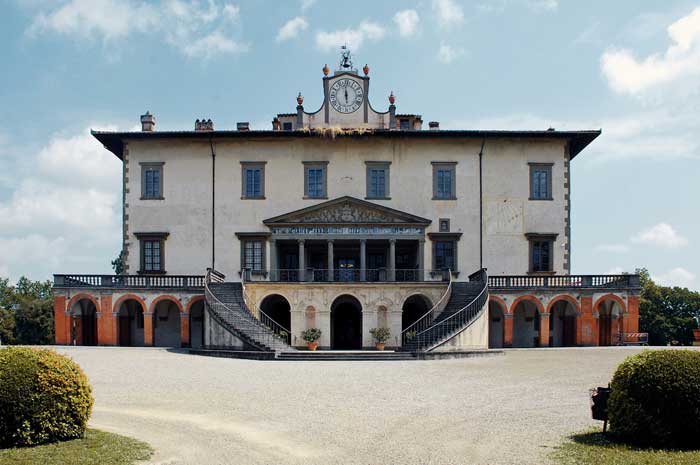 |
||
Villa Medicea at Poggio a Caiano |
||
| The Medici Villa at Poggio a Caiano was built for Lorenzo de Medici and designed by Giuliano da Sangallo between 1485 and 1520, and it is a wonderful example of Renaissance architecture. Poggio a Caiano is situated north-west of Florence. Poggio a Caiano is most visited for its highly renowned Medici Villa. This Grand Ducal villa is situated on a hill on the shores of the river Ombrone and is one of the most beautiful in Tuscany. The building of the villa was almost entirely due to Laurence the Magnificent who built the Medici Villa on the site of an ancient castle which once belonged to the powerful Cancellieri family of Pistoia. After 1420 it was bought by the Strozzi and finally by the Medici. The construction of the Villa of Poggio a Caiano started in 1485 and followed the purchase on behalf of Lorenzo the Magnificent in 1473 of a large territory which surrounds the villa. In 1552 the secret garden was planted. This could be reached by crossing a bridge and was separated from the main garden by a small road. The garden, as can be seen in the lunette of the Villa by Giusto Utens, (between 1599 and 1602) has a traditional cross shape, with four major and eight minor partitions. In the center a small wooded area was planted to obtain a nearby hunting ground righi behind the Villa. In the mid-16th century, under Cosimo I (1519-1574), Niccolo Tribolo re-arranged the gardens in English and Italian style, and he finished the construction of the stables around 1548. The gardens are decorated with rare plants and statues, such as a terracotta depicting the capture of the nymph Ambra by Ombrone as described by Lorenzo de Medici in his poem called Ambra. The exterior of the Villa has preserved the original Renaissance plan from Sangallo but the two staircases leading to the terrace were built in the early 19th century to replace the original ones designed by Pasquale Poccianti. At the top of the stairs there is a loggia surmounted by a pediment and a vaulted ceiling decorated with reliefs. On the right wall of the gallery stands a decorative fresco depicting the Sacrifice of Laocoon, by Filippino Lippi (1457-1504). On the lintel of the same lodge there is a glazed frieze which represents the journey of the soul. This work has been subject to many interpretations, but in general we can say that it tells the Platonic myth of the history of the soul. The interior of the Villa has undergone several transformations over the years that have altered its original appearance. In the ground floor room you can visit the apartment of Bianca Cappello. Also notable are the entrance hall, the billiard room and the 18th-century court theater. On the first floor in the center of the building is the hall of Pope Leo X which was probably completed around 1513. The pictorial decoration of the walls is by Andrea del Sarto (1486-1531), Pontormo (1494-1557), Franciabigio and Alessandro Allori (1535-1607). Gardens in Tuscany | Villa Medici in Poggio a Caiano |
||
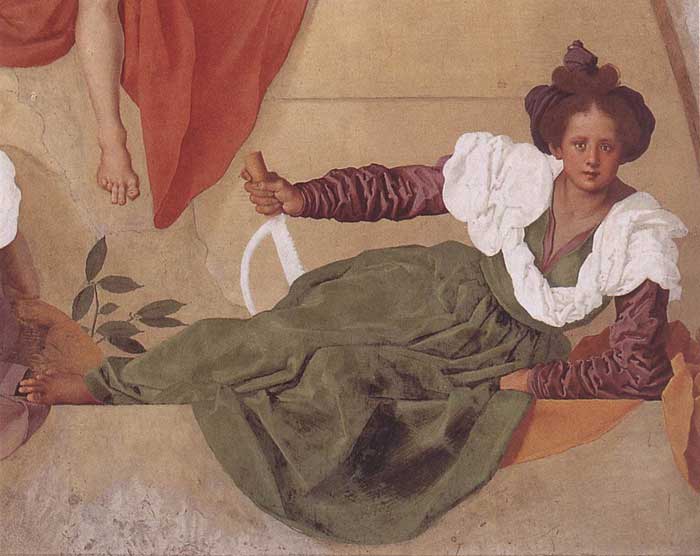 |
||
| Jacopo Pontormo, Vertumnus and Pomona (detail, reclining woman), 1519-21, Villa Medicea di Poggio a Caiano, Poggio a Caiano |
||
|
Enlarge map Villa Medicea at Poggio a Caiano |
||
|
||||
[8] Modern analytical techniques have allowed re-evaluation of the cause of death of Francesco I de' Medici and his wife, Bianca Cappello. It now seems that the grand-ducal couple died of acute arsenic poisoning and not malaria as previously believed
|
||||
Bibliography Pozzana, Mariachiara, Gardens of Florence and Tuscany (Giunti Editore, 2001) |
||||
This page uses material from the Wikipedia article Bianca Cappello published under the GNU Free Documentation License. |
||||
|
||||
Podere Santa Pia, giardino |
Podere Santa Pia |
Florence, Duomo |
||
 |
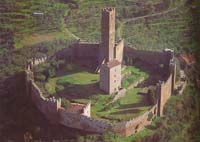 |
 |
||
The Villa Tommasi in Metelliano |
Castiglion Fiorentino, castello |
Siena, duomo |
||
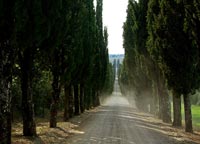 |
||||
Villa Arceno gardens |
Abbey of Sant 'Antimo |
Villa La Pietra, near Florence |
||
| Chiesa di Santa Maria Novella Address | Piazza di Santa Maria Novella, 50123 Firenze (FI) Opening hours | Open weekdays 9 a.m. - 5.30 p.m. Fridays 11 a.m. - 5.30 p.m. Saturdays 9 a.m. - 5 p.m. Sundays and religious holidays 1 p.m. - 5 p.m. The museum, adjacent to the church, is managed by the city of Florence and foresees a separate admission fee. The ticket includes a visit to the Green Cloister with frescoes by Paolo Uccello with scenes from the Old Testament and, being outside, are in bad shape but can still be admired. The Chapter House, called the Cappellone degli Spagnoli or Spanish Chapel ever since it was used by the courtiers of Eleanor of Toledo, wife of Cosimo I. The chapel features frescoes by Andrea di Bonaiuto depicting Jesus Christ's passion, death and resurrection on the front wall as you enter. To the right, in the Triumph of the Doctrine, the dogs of God (a pun on the word Dominican - domini canes) are sent to round up lost sheep into the fold of the church. To the left, another fresco the Triumph of the Catholic Doctrine while the entrance wall frescoes depict stories of the life of St. Peter Martyr. The tour ends in the ancient refectory where precious liturgical objects belonging to the church's sacristy are on display as well as a few recovered synopses from Orcagna's frescoes in the Tornabuoni chapel. |
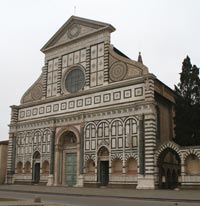 |
|||
| Choosing one of the Florence walking tours you'll be able to visit the world-famous museums of the Uffizi and Accademia Galleries, discovering the main historical and artistic treasures of the city. The tours focus on Florence's major sights and attractions, including the Duomo, the Ponte Vecchio and the city's famous churches and Renaissance palaces. Novelist Henry James called Florence a “rounded pearl of cities -- cheerful, compact, complete -- full of a delicious mixture of beauty and convenience.” The best way to experience the Italian city’s artistry, history and joy of life is by walking the same paths that the Medicis, Michelangelo and James once used. 1 | A Walk Around the Uffizi Gallery 2 | Quarter Duomo and Signoria Square 3 | Around Piazza della Repubblica 5 | San Niccolo Neighbourhood in Oltrarno |
|
|||
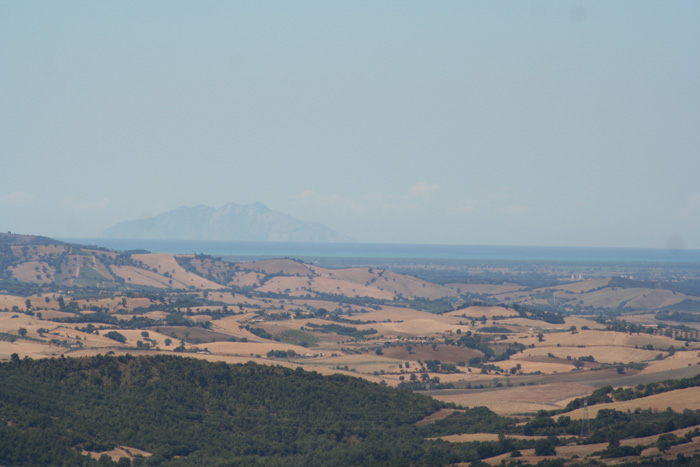 Podere Santa Pia is set high up in the Maremma hills with sweeping views of Tuscany |
||||

